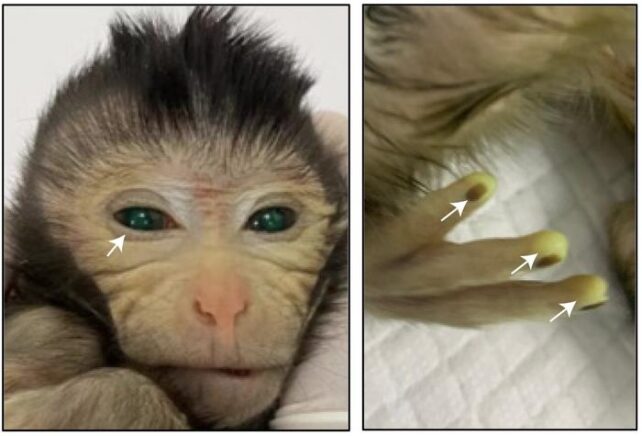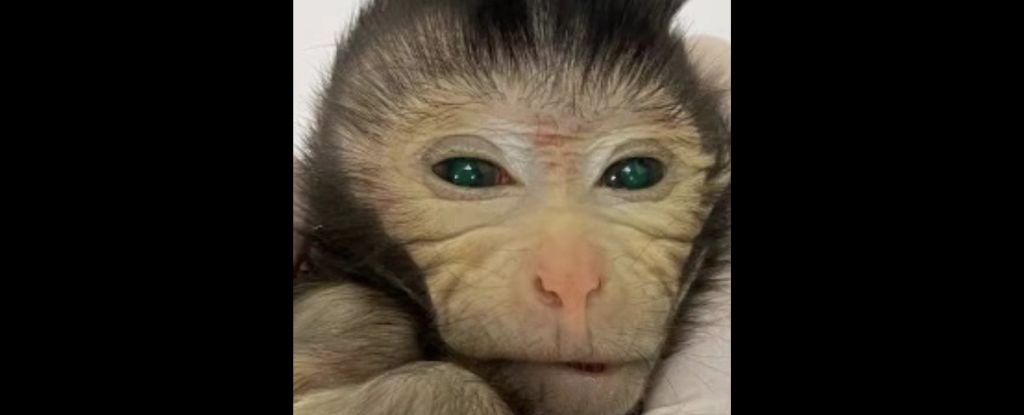Products You May Like
Scientists in China have announced the birth of a primate like no other, with eyes that shined green and fingertips that glowed yellow – and those were just the observable features.
Beneath the skin and deep within its genes, this creature was apparently even more remarkable.
The lab-born male monkey was the product of an unprecedented experiment, which used the pluripotent stem cells of two genetically distinct fertilized eggs from the same monkey species to create one living and breathing long-tailed macaque (Macaca fascicularis).
This is not the world’s first living monkey artificially formed from the fusion of multiple fertilized eggs, but it was the most mixed – or chimeric – of them all, according to researchers in China and the UK.
In science, an animal ‘chimera’ is a single organism made up of cells that derive from more than just two parents.
In this particular animal’s body, the cells and tissues created from two separate stem cell lines, one from a donor embryo and another from a host embryo, were apparent in the brain, heart, kidney, liver, gastrointestinal tract, testes, and the cells that turn into its sperm.
Of the 26 different tissue types that scientists measured in the live monkey, the contribution of extra donated stem cells ranged from a low of 21 percent all the way up to 92 percent. This highest percentage was seen in brain tissues.
Previous studies have resulted in liveborn and terminated monkey chimeric fetuses before, with offspring containing low donor cell contributions to various tissues of between 0.1 and 4.5 percent.
The newest chimeric monkey blew those stats out of the water. It survived for just ten days, which means the ongoing health of chimeric monkeys is still a problem to be solved.
“This is a long-sought goal in the field,” says reproductive engineer and senior author Zhen Liu of the Chinese Academy of Sciences (CAS).
“Specifically, this work could help us to generate more precise monkey models for studying neurological diseases as well as for other biomedicine studies.”
In a media conference, the lead author of the paper, geneticist Jing Cao from CAS, said that this was a basic scientific advance because it proves for the first time that rich non-human primate chimeras are possible.
The field of chimeric animal research isn’t without a spectrum of ethical concerns, though proponents maintain the benefits of accurate models in testing diseases and therapies make their efforts worthwhile.
Since donor stem cells can be genetically edited, biomedical researchers could potentially test certain disease outcomes in monkey models in the future. While it depends on the research purpose, the higher the contribution of the donor stem cells in any target tissue, the more accurate the disease model can be.
In egg and sperm cells, a percentage of chimerism as low as 10 percent can be a useful model, according to immunologist Miguel Esteban from CAS and the Beijing Genomics Institute, as these germ lines can theoretically transfer to offspring.

In 2012, the first live chimeric monkeys were reported, but the donor cells in these creatures contributed to their tissues at very low percentages (only around 4 percent).
What’s more, these chimeric tissues were “limited to organs rich in blood”, like the liver, spleen, and placenta, which suggests “blood mixture could be involved rather than true chimerism in solid tissues.”
The glowing solid tissues of this new chimeric monkey are filling scientists with delight.
When the team in China injected a donor set of pluripotent stem cells (which can differentiate into all cell types) into week-old monkey blastocyst embryos, they made sure to label the donations with green fluorescent protein.
This way, any tissue or cell glowing green in the offspring could be clearly tied to the donated stem cell line.
When these carefully engineered embryos were implanted into female macaques, only six live births ensued, and only one of these live monkeys, a male, showed stem-cell-derived tissue in multiple regions of its body.
One of the aborted fetuses also showed some level of chimerism, albeit at a lower percentage than the live chimeric monkey, however, this fetus did not make it to birth.
Cao and colleagues admit that the overall efficiency of this process “remains low” (about half as successful as creating an embryo without chimerism from in vitro fertilization), but it’s a promising step in the right direction.
The low efficiency could be due to how the stem cells or the embryos are cultured in the lab. For instance, when donor stem cells are injected into a host embryo, many cells undergo programmed cell death, so improving the survival rate in both the embryo and fetus is an ongoing challenge the team hopes to refine in the future.
The research, Liu says, could help scientists better understand the early stages of stem cell differentiation in primates, which is not nearly as well studied as in mice.
“[W]e have provided strong evidence that naive monkey pluripotent stem cells possess the capability of differentiating in vivo into all the various tissues composing a monkey body,” says Esteban.
“This study deepens our understanding of the developmental potential of pluripotent stem cells in primate species.”
The study was published in Cell.
